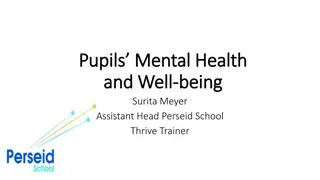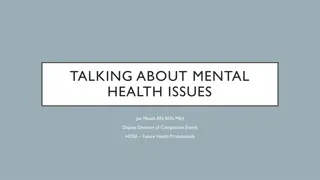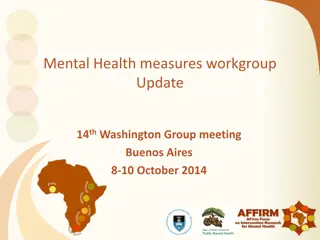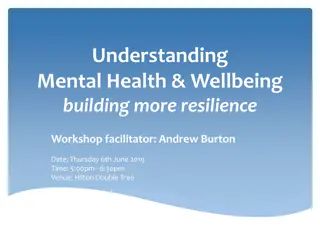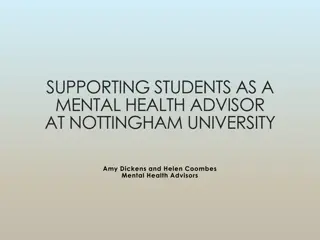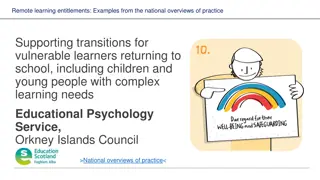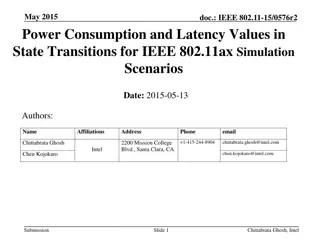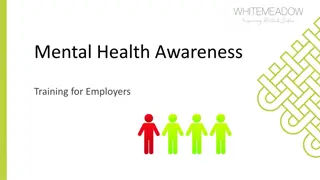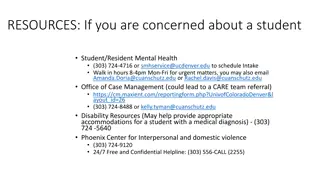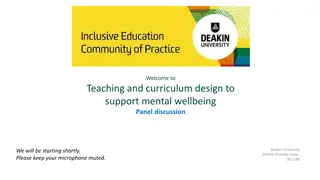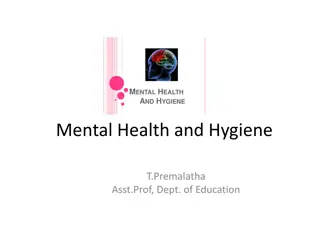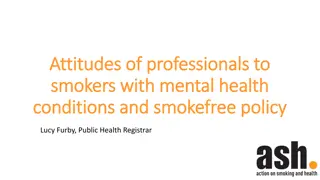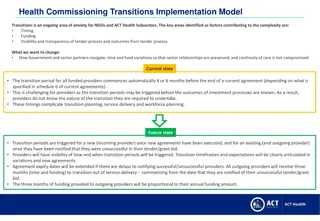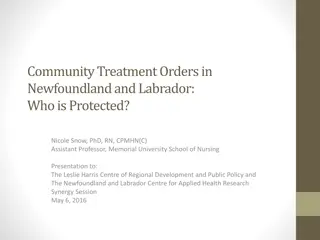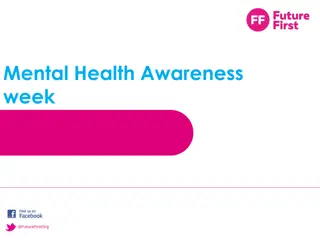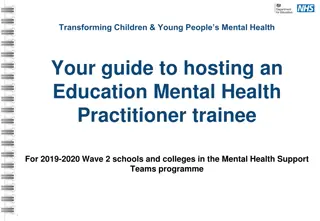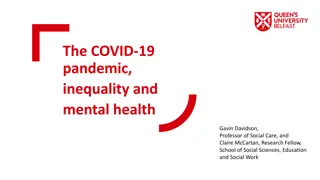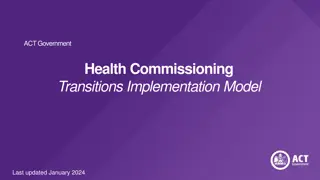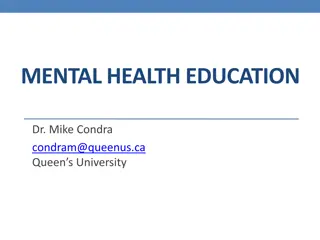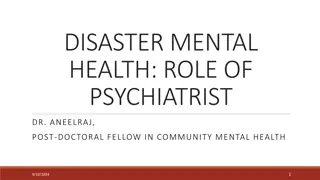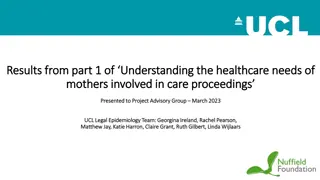Understanding Student Mental Health Challenges in University Transitions
Addressing the prevalent mental health difficulties among university students is crucial, as highlighted by research findings. Students face higher anxiety rates and lower levels of mental well-being compared to the general population, emphasizing the need for inclusive teaching practices. With a background in supporting student well-being, the senior lecturer aims to promote mental health awareness through pedagogical strategies and discussions on inclusive teaching approaches.
Download Presentation

Please find below an Image/Link to download the presentation.
The content on the website is provided AS IS for your information and personal use only. It may not be sold, licensed, or shared on other websites without obtaining consent from the author. Download presentation by click this link. If you encounter any issues during the download, it is possible that the publisher has removed the file from their server.
E N D
Presentation Transcript
Starting well: Supporting student mental health & wellbeing through transitions to university Senior Lecturer in Education and Sociology Equality, Diversity and Inclusion festival, 2022, University of Portsmouth charlotte.morris@port.ac.uk
Overview 1. Overview of student mental health & wellbeing challenges; 2. Case Study: pedagogical strategies being developed by one module team first year 40 credit core module; 3. Discussion time: Consider inclusive teaching practices to support student mental health and wellbeing in your teaching contexts.
My background 2005 2010 researcher on Aim Higher & HEFCE funded student mental health and wellbeing and inclusive pedagogical practice projects, Anglia Ruskin University and University of Brighton; 2010 2011 HEA funded postgraduate wellbeing project, University of Brighton 2011 2017 Student Support and Guidance Tutor at University of Brighton & further widening participation and wellbeing initiatives; 2013 2014 Research Hive Scholar, University of Sussex- leading peer support and wellbeing initiatives; 2013 2020 Teaching at University of Sussex, led foundation course supporting transitions to HE; 2020 Joined UoP, lead core first year module.
Joining the dots Wellbeing Learning Inclusivity Equity Social justice Difference & diversity Belonging Engagement
High prevalence of mental health difficulties in student populations; (Bewick et al. 2008; Grant et al. 2000) & risk of self-harm and suicide (Stanley, 2007); Students vulnerable in relation to mental illness (de Jonge, Omran, Faulkner & Sabiston, 2020). Students have reported significantly lower levels of mental wellbeing and higher levels of anxiety than general population (Neves & Hillman, 2016); Students may experience higher anxiety rates than other populations (Rogowska, Pavlova, Kusnierz, Ochnik, Bodnar & Petrytsa, 2020 ). Anxieties about academic work can have a profound impact on wellbeing (Grant, 2002; Morris, 2011) HEFCE survey 2015 75% had disclosed a mental health issue to a friend. NUS survey 2016 78% (over 1000 surveyed) said had experienced mental health issue in last year (54% of these did not seek help); Focus for Office for Students universities called on to prioritise mental wellbeing. Student mental health and wellbeing: Ongoing concerns
Number of students seeking help for mental health problems - wider crisis of young people s mental health within the UK (Shackle, 2019); Increasing levels of mental illness, distress, and low wellbeing among UK university students (Thorley, 2017). 21% of students rate themselves with low anxiety in contrast with 43% of non-students the same age (Cage, Stock, Sharpington, Pitman & Batchelor, 2020); 18 25 age most likely for mental health problems to emerge (Royal College Psychiatrists Report on Student Mental Health 2003; 2011); Need to understand and offer effective and accessible support (Brown, 2018); Need to respect students wishes for support (Batchelor, Pitman, Sharpington, Stock & Cage, 2020). Student mental health and wellbeing: Background
Impacts of marketized environment: introduction of fees and rising accommodation costs (Gregor, 2018). Decade of austerity in UK context stress on families, less support for students (RCPR, 2011) + cuts to young people s and health services, including specialised mental health services. Academic, financial, and social pressures - added risk for poorer mental health (Thorley, 2017); Increased competition for graduates, engendering anxiety about future careers (RCPR 2011). Students perceptions that they need to achieve good enough results to further themselves in a competitive job market (Gregor, 2018). High pressures to perform can mean self-worth reduced to academic outcomes (Shackle, 2019); Increasing course and class sizes - may receive lower levels of personalised support (Brown, 2018) era of massification. Students (& young people more generally) have struggled with loneliness, anxiety, and depression due to the uncertainty faced from the pandemic and restrictions (Hall, 2020); Anxieties around global challenges conflict, climate change, uncertainties. Causes & context
Histories of discrimination and prejudice in education; Can feel like outsiders in universities (tend to be middle-class, white), lack of belonging, isolation, lack of role models; LGBTQ+ students more at risk (Smithies and Byrom, 2018) Time of experimentation, new freedoms identity, lifestyle, - may be transitioning, coming out; Widespread gender-based violence and harassment on university campuses (Jackson and Sunduram, 2020; Phipps and Young, 2015); Challenges for mature students, student parents / carers; International students at risk of isolation, affected by conflict, displacement, discrimination; away from support, under pressure to support families financially. Links with equality, diversity and inclusion
Universities as emotion free zones (Leathwood and Hey, 2009); Burke (2015) looks at neoliberalism and impact of climate of competition on emotions: Move towards hyper-individualism specific performative and instrumentalist model of success are mobilised. Difference and emotions posed as dangerous forces which require homogenizing and neutralizing. Emotion in higher education Notion of diversity embraced as a marketing tool without problematizing ways in which diversity is intertwined with difference and misrecognition . Characteristics associated with difference in HE such as being emotional / caring in need of regulation and control. Other bodies become marked as different through reference to racialized, gendered and classed discourses: The injuries of misrecognition are embodied, through the internalization of shame, and are tied to the emotional level of experience (Burke, 2015, p.394)
A major issue which can prevent students from coming forward about mental health problems is ongoing stigma surrounding mental health in our society (Thornicroft 2006) - may be even more pronounced in some International students countries of origin. While student support services employ specialist staff to help students cope with mental health difficulties, these services are not always accessed as they themselves are often stigmatised (Stanley 2007). Early intervention is essential in order to protect at risk students (Stanley 2007) and so encouraging support seeking at the earliest opportunity -before their mental health deteriorates - is an ongoing challenge for academic and support staff. Sources of support should therefore be highly visible and accessible encouraging an academic culture which normalises support seeking can be complemented through mental health and wellbeing promotion (Morris 2011). Stigma
Role of academic staff Students experiencing emotional distress / mental health challenges most likely to disclose and seek support from academic staff (after friends and family); Staff can lack confidence, be anxious, fearful and disempowered; Can lack training and resources; Importance of availability, non-judgemental listening; Signposting to support / information and encouraging support seeking; Becoming educated about mental health and wellbeing, recognising signs; Playing role in raising awareness and challenging stigma whole university approach (Morris, 2010; 2011)
Importance of the academic setting in facilitating students confidence and sense of belonging (Thomas 2012) which relates closely to wellbeing (Carroll 2011). Emotions, confidence, self-esteem and positive relationship formation (Wilcox, Winn and Fyvie-Gauld 2005). One study compared two programmes with contrasting retention rates, within one institution, and identified that individual students psychological states were strongly associated with withdrawal (Trotter and Roberts 2006: 374). However, links with wellbeing tends to be implicit: 2008 HEA report (by Yorke and Longden) on the first year experience begins to explicitly link wellbeing and retention concerns: Stress due to personal health problems, a lack of support, the demands of the programme, lack of contact with staff and potentially coping with failure. Importance of an institutional ethos in nurturing a sense of belonging, particularly in the early pre-entry and induction phases importance of meaningful staff / student interactions (Thomas, 2012) & groupwork (Masika and Jones, 2016). Student mental health &wellbeing - engagement
First year undergraduate students are especially vulnerable as the process of adapting to independent living and making friends can be challenging. Transitional periods including starting university but also transitioning between different stages of a degree can be highly stressful, exacerbate pre-existing conditions; Risk of student suicide increases at these times (Stanley 2007); Transitions often messy, complex not clearcut, linear & straightforward. Transitions and wellbeing
Retention studies have consistently identified the first year as a crucial phase (see for example Trotter and Roberts 2006) and highlight the need to ensure a good student experience (Yorke 1999; 2004; Yorke and Longden 2008). Preparedness of students for higher education, in the light of widening participation key (for example, Byrne and Flood 2005; Tinto 1993; 1997; Importance of institutional support for enabling successful academic transitions recognised as essential for students from deprived socio- economic backgrounds (Thomas 2002). First year
Isolation distance from support networks; Adjustment to new environment / culture; Exposure to multiple forms of discrimination. Lifestyle health factors; Exposure to drugs & alcohol; Commercialisation of the student experience ; Independent living; Information overload; Different expectations as learners coming from highly structured school / college environments / Different International contexts. First year challenges in summary
Spratt (2017) identifies five ways in which wellbeing is spoken about in relation to education 1. Physical health promotion; 2. Social and emotional literacy management of emotions; 3. Care ethos, relationships, ensuring rights; 4. Flourishing (eudaimonic approach); 5. Sustainability (linked to social justice). Different approaches to wellbeing in education Stresses importance of enabling flourishing (rather than focussing narrowly on feelings of happiness). Access to resources / conditions needed to thrive; Holistic: Interconnected domains of physical, emotional, intellectual, social, spiritual domains;
Some programmes may take an overly prescriptive individualised view of wellbeing (Spratt, 2017) - can be reduced to individualised skill-set; Synonymous with success , high performance instrumental. May neglect learners own personal understandings of wellbeing (Coppock, 2010); Imposing single framework may exclude minority group voice, have different priorities (Watson et al., 2012); Tendency to apply objective measures & neglect situational aspects of social and emotional wellbeing; Wellbeing as subjectively experienced, contextual, relational (Watson et al, 2012). Critiques of current approaches
Education of whole learner rather than collection of discrete, fragmented attributes, needs. Placing care at heart of what we do informing vision and ethos. Care and wellbeing Importance of dialogue and caring relationships across the whole learning community. Educators and learners respond to each other as whole persons.
Provide foundation for learning through whole degree; Runs through whole of year 1. The module Taught by team of 7 tutors / seminar leaders; Includes workshops on academic development.
Our teaching approach Relational & caring; Preparedness; Personalisation; Inclusivity; Whole year induction; Supportive communities.
Managing expectations of exactly how much support students can expect from us - introduced in induction lecture on studying in HE and discussions in the early tutorials, being boundaried and clear about availability. Demystifying HE (and inclusive practice), especially around language - explaining concepts and terms as we go along, asking students to share different definitions being clear there isn t a wrong answer . Encouraging use of a reading record to orientate and break down readings and develop critical thinking through questioning. Modelling what we expect from students in terms of behaviour and via our materials is important. Reiteration of who / where to go for what; Tutorials designed to help students succeed focus on time management, confidence building, communication skills. Preparedness
Small group tutorials combined with seminars. Emphasis on getting to know each other; Empowerment rather than deficit approach - valuing the experiences, qualities, capacities, skills, knowledge and insights students bring. Including plenty of opportunities for students to draw on their personal and professional experiences through reflection and in discussion and explicitly recognise this as valuable knowledge. Empowering students to identify and share useful resources which can inform learning and teaching (flipped learning can be useful). Capturing and valuing students discussions as learning resources to build on - via flipcharts / padlets or other online capture tools. Cultural relevance - linking curricula to students own communities, interests and concerns, drawing on stories, reflections and observations as important resources in knowledge building. Personalisation
Recognising and anticipating diverse needs of learners; Repeating back to students (mirroring) to check our understanding of what they ve said and also their understanding. Lots of questions and prompts to enable them to contribute and move their thinking forwards. Carefully scaffolding activities - introducing with as much detail as possible so students know what is expected of them. Providing links to relevant resources and opportunities to grow confidence in research skills. Inclusivity
Higher levels of support and contact time at the beginning then gradually enabling students to become more independent as learners; Knowing learners, at different stages in journeys, developing at different paces, in different ways. Reflection - encouraging metacognition (awareness of themselves as learners) & develop narrative: Allowing space in each session to reflect and link topics to experiences to complement discussions can be powerful in making learning meaningful. Reflective writing can help build confidence in writing generally and also in developing positions on topics; Opportunities to build confidence in presenting, group work and different modes of writing; Making explicit relevance of what we are doing and opportunities to develop skills, capacities, awareness. Whole year induction
Importance of getting to know each other through one- to-one discussions with tutors and in sessions as far as possible students are placed with their tutors; Having same seminar leader all the way through the year; Staying in contact, checking in when absent, noticing if students are not themselves, following up. Regular communications, signposting and providing links normalising asking for help and making it possible. Creating safe spaces through co-constructed ground rules; not putting students under pressure to share personal experiences & opportunities to contribute anonymously. Ensure we provide trigger warnings and signpost to support where content could be distressing. Setting students up in peer bubbles for mutual support through the year, lots of icebreakers and opportunities for groupwork encourage to look out for each other. Opportunities to talk about mental health & wellbeing in tutorials and via the curriculum normalises talking about these issues and providing mutual support. Supportive learning communities to foster belonging
Discussion points Consider students and learning in your teaching context. What challenges do students face as they undergo learning transitions / transitions to university life? What pedagogical practices can best support students wellbeing? What opportunities are there to support student wellbeing through the curriculum? In what ways are wellbeing and learning interconnected? Any questions or inclusive practices to share?
Thank you for participating! References available on request
Addressing ongoing inequalities; ensuring access to resources. Being accepted into community; Wellbeing and belonging in universities Ensuring everyone has a voice, influence decision; Recognising and valuing diverse histories; Emphasis on interdependencies and care; Social learning opportunities; Inclusive learning spaces;










